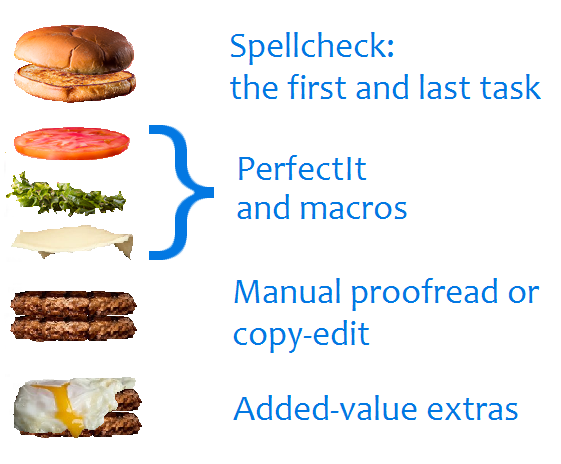Proofreading service burger!
When is a proofreading service not a proofreading service?
When it's a whoppy-edit!
I might just be hungry, but I think the build-a-burger model is a neat analogy for a proofreading service. Or proof-editing service. Or copy-editing service, or, indeed, any other document improvement service that you can name. After all: it's about your project, your requirements, your appetite.
So, coming up in the next few articles are some examples of service levels and their corresponding burger-stack descriptions, from a standard proofreading service, to the slightly meatier fast-food-style proof-editing service before we wrap our chops around the entirely satiating bespoke build-a-burger masterpiece that is the whoppy-edit..
In this first article, I take a look at the layers. I'm laying out the tools of the trade that I employ as standard to give you an insider's guide to my typical proofreading service, proof-editing service, and the component parts of bespoke build-a-burger-style creations such as the whoppy-edit.
The basic ingredients at the burger bar a.k.a. the stages of a proofreading/editing service

The spellcheck is the first and last part of any proofreading/copy-editing/whoppy-editing service
The bread and butter. Most clients have done this themselves but regardless, this is where it starts and ends. This is the final thing to do because accidental typos can easily go un-noticed. Imagine a perfect report, completely error-free, until a cat or a stray elbow leans on the keyboard and types a bit of lqkdlwefj in the middle. This is why the spellcheck is the last line of defence. I also use it at the start of the project to give me a glimpse at what is to come.
Professional editing tools such as PerfectIt and a variety of macros contribute to a high-quality proofreading service
I intend to write more about these in a future article, but for now I will say that PerfectIt is great for ensuring consistency of style, UK or US English norms, correct/appropriate hyphenation, use of abbreviations etc. I use several macros, depending on the needs of the project, to do specific things such as assess whether the report is written chiefly in UK or US English, to analyse the document and report back on how many of each type of inconsistency appears in the use of punctuation and grammar points. And, the best macro of all, in my opinion, courtesy of Paul Beverley, is ProperNounAlyse. An awesome macro (if you like that sort of thing) that has, among other victories, saved many a client from incorrectly spelling their end client's name.
These tools are, of course, nothing by themselves, but as part of a professional proofreading service, they are like running a carwash with a pressure washer instead of just your elbow grease: the quality of the proofreading service is increased. The digital age has revolutionised publishing, and technical reports, business publications and indeed all forms of written document can be proofread more reliably, more efficiently and more thoroughly by embracing the best available technologies to support the provision of a proofreading and editing service.
It's the cheese and the salad, and it comes at the top and the bottom of the whoppy-editing service.
The manual proofread or copy-edit is the meaty heart of the service
If a proofreading service were just a load of semi-automatic tools, then it would be super-quick, cheap and could be outsourced to anyone, anywhere. I cannot at present envisage a way in which this could deliver what any client needs (if I could, then I'd assemble the service and get rich!).
A burger without meat (or meat substitute for the veggies) is like a proofreading service without a manual proofread: a scam!
In some cases, this will be a proofread with two read-throughs, or maybe a copy-edit then a proofread. In this awesome analogy, each burger is a read-through with either a proofreading or a copy-editing hat on.
If a double burger doesn't satisfy your needs, then sometimes you need round two. A two-stage editing service – where the edited or proofread version goes back to the author with queries before coming back for round two from the proofreader/copy-editor – is sometimes required, particularly when the author is a non-native English speaker writing in their second (or sometimes third or fourth) language. This is used in cases where there is the need for the author to clarify some things in order to enable the document to be finalised, such as when the proofread or copy-edit has raised a significant number of questions about the meaning, structure or formatting of all or part of the document.
Added-value services like reference-building and heavy editing: the eggy burger
Maybe a multi-author report needs the style to be normalised across all of the sections, or perhaps the referencing needs rebuilding, e.g. researching the correct references, adding them to the reference list, deleting unused references and completing incomplete references: this is build-a-burger and your needs can be met – as long as there is enough time and money to get it done, then we can find a way.
Hopefully this has given a flavour of the sort of things that can be included in a proofreading or copy-editing or whatchamacallit service.
